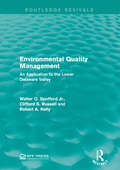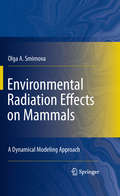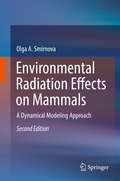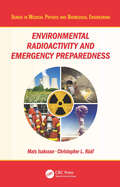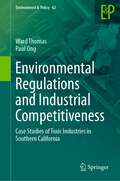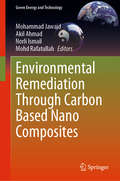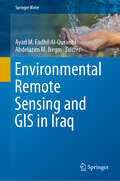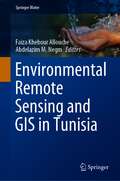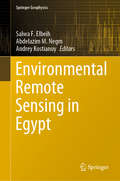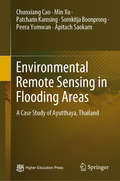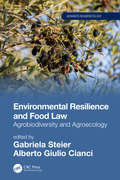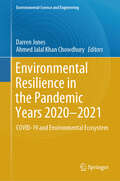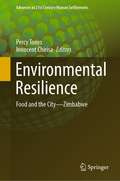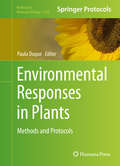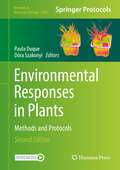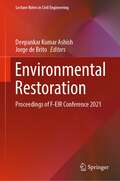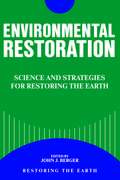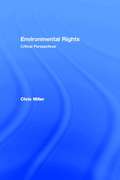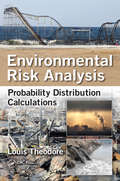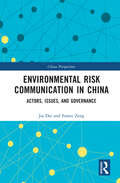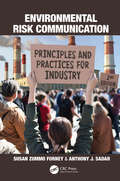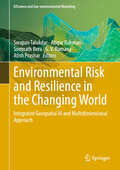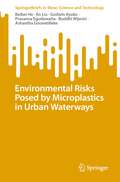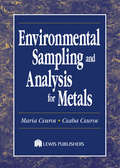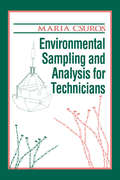- Table View
- List View
Environmental Quality Management: An Application to the Lower Delaware Valley (Routledge Revivals)
by Walter O. Spofford Jr. Clifford S. Russell Robert A. KellyEnvironmental Quality Management provides a quantitative analysis of regional residuals environmental quality management in the Lower Delaware Valley. Originally published in 1976, this study takes a management outlook to discuss new systems such as a non-linear aquatic eco-system model and reaches conclusions which have influenced research and management decisions about REQM across the world. This title will be of interest to students of Environmental Studies.
Environmental Radiation Effects on Mammals
by Olga A. SmirnovaThe monograph is devoted to theoretical studies of radiation effects on mammals. It investigates the effects of both acute and chronic irradiation on vital body systems (hematopoiesis, small intestine, and humoral immunity), on the development of autoimmune diseases and on the mortality dynamics in homogeneous and nonhomogeneous (in radiosensitivity) mammalian populations. All are set within the framework of biologically motivated mathematical models. The developed methodology of the studies, the models themselves, and the obtained results are of a great theoretical significance and can find wide practical use for those dealing with the problems of environmental protection and radiation safety.
Environmental Radiation Effects on Mammals
by Olga A. SmirnovaDr. Smirnova's updated text is devoted to the theoretical studies of radiation effects on mammals. It summarizes 35 years of results the author obtained from analyzing dose rate equivalents for the Galactic Cosmic Rays (GCR) and for Solar Particles Events (SPE). This edition also includes two new chapters on skin epidermal epithelium and risk assessment for myeloid leukemia, as well as extended revisions addressing the radiation effects on the blood-forming system. Mathematical models are used to explain the effects of both acute and chronic irradiation on the dynamics of vital body systems, like the hematopoietic system, the development of autoimmune diseases, and the mortality dynamics in homogeneous and nonhomogeneous mammalian populations. The proposed methodology of these studies, the models themselves, and the obtained results are of a great theoretical significance and can find wide practical use.
Environmental Radioactivity and Emergency Preparedness (Series in Medical Physics and Biomedical Engineering)
by Mats Isaksson Christopher L. RaafRadioactive sources such as nuclear power installations can pose a great threat to both humans and our environment. How do we measure, model and regulate such threats? Environmental Radioactivity and Emergency Preparedness addresses these topical questions and aims to plug the gap in the lack of comprehensive literature in this field. The book explores how to deal with the threats posed by different radiological sources, including those that are lost or hidden, and the issues posed by the use of such sources. It presents measurement methods and approaches to model and quantify the extent of threat, and also presents strategies for emergency preparedness, such as strategies for first-responders and radiological triage in case an accident should happen. Containing the latest recommendations and procedures from bodies such as the IAEA, this book is an essential reference for both students and academicians studying radiation safety, as well as for radiation protection experts in public bodies or in the industry.
Environmental Regulations and Industrial Competitiveness: Case Studies of Toxic Industries in Southern California (Environment & Policy #62)
by Ward Thomas Paul OngWhile polluting industries in the U.S. continue to emit billions of pounds of toxic chemicals into the air, land and water every year, many economists and policy makers argue that environmental regulations stifle economic growth and reduce the standard of living for the American people. This book takes a fresh look at this question through three case studies of highly regulated polluting industries in the Southern California region: metal finishing, wood furniture, and dry cleaning. The case studies are based on a mix of qualitative and quantitative methods, including in-depth interviews with corporate managers and environmental regulators. The authors find that there is no universal pattern for predicting the effects of environmental regulations on industrial competitiveness, but that the outcomes depend on the structure of the industry being regulated, the design of the regulations, and the technologies that are available for compliance. The book is written in straight forward language that is accessible to the non-economist and will prove an essential resource for academics and students of all levels, and professionals and policy makers in the fields of environmental policy and regional economic development.
Environmental Remediation Through Carbon Based Nano Composites (Green Energy and Technology)
by Mohammad Jawaid Norli Ismail Akil Ahmad Mohd RafatullahThis book examines carbon-based nanocomposite materials and their application in various environmental fields, such as wastewater treatment, and air and soil remediation. Featuring illustrations, and tables summarizing the latest research, it gathers up-to-date information on the application of carbon nanocomposites in the removal of environmental pollutants from different sources. Given its scope, the book is a valuable textbook for research students, and a useful handbook and reference resource for researchers, academics and industrial scientists working in the field of environmental pollutants and their safe removal.
Environmental Remote Sensing and GIS in Iraq (Springer Water)
by Abdelazim M. Negm Ayad M. Fadhil Al-QuraishiThis unique book focuses on remote sensing (RS) and geographical information systems (GIS) in Iraq. The environmental applications include monitoring and mapping soil salinity and prediction of soil properties, monitoring and mapping of land threats, proximal sensing for soil monitoring and soil fertility, spatiotemporal land use/cover, agricultural drought monitoring, hydrological applications including spatial rainfall distribution, surface runoff and drought control, geo-morphometric analysis and flood simulation, hydrologic and hydraulic modelling and the effective management of water resources. Also, this book assesses the impacts of climate change on natural resources using both RS and GIS, as well as other applications, covering different parts of Iraq. The book chapters include tens of maps extracted from the remotely sensed datasets, in addition to tables and statistical relations obtained from the results of the studies of the chapters' authors. These studies have been conducted in different parts of Iraq; in the north (Kurdistan region) with its mountainous and undulating lands, in western parts which have desert soils, and in central and southern Iraq where there are salty soils, dunes, wetlands, and marshes.The book is written by distinguished scientists from Iraq, China, USA, Italy, Iran, Germany, and the Czech Republic who are interested in the Iraqi environment. The book is therefore a useful source of information and knowledge on Iraqi environment for graduate students, researchers, policy planners, and stakeholders in Iraq as well as similar regions.
Environmental Remote Sensing and GIS in Tunisia (Springer Water)
by Abdelazim M. Negm Faiza Khebour AlloucheThis book focuses on monitoring and assessing various environmental processes in Tunisia using state-of-the-art remote sensing and GIS technologies. In addition to addressing the diversity of Tunisian landscapes and providing spatial analysis of natural, cultivated and urbanized environments. It presents and discusses several case studies on integrated RS / GIS approaches for mapping, modeling, monitoring and evaluation. Moreover, in this volume authored by experts in the topic from Tunisia and other countries, authors assess the agro-environmental applications from Tunisia and offer different methods and applications to environmental processes and risks including drought, degradation, flood, planning, Yield estimation, dust storm detection, dry land vulnerability, wetland dynamics and others. The material presented here will help decision-makers plan sustainable landscape and agricultural management policies that preserve biodiversity and contribute to achieving sustainability goals and for researchers, it will expose methodological approaches used in different fields of research. Graduate students and Practionioner engineers working in the field of RS/GIS will also benefit from the book. The book ends with a set of conclusions and recommendations to support researchers underscoring the need for further research in this area.
Environmental Remote Sensing in Egypt (Springer Geophysics)
by Abdelazim M. Negm Salwa F. Elbeih Andrey KostianoyThis book presents a comprehensive selection of applications employed in environmental remote sensing using optical and thermal infrared satellite-sensors aiming to map natural resources, crops, groundwater, surface water, aquatic ecosystem, land degradation, air quality, renewable energy, regional resources, and climate-related geophysical processes. The technologies presented in this book also include satellite images, space-borne radar sensors focusing on the most versatile one, data from synthetic aperture radar (SAR), scatterometers and radar altimeters in Egypt. This volume also presents a thorough explanation of the remote sensing role showing physical fundamentals of the climate change phenomenon including gas emissions, and the impact on resources concerning the sustainable development of Egypt. Besides, the book includes an analysis of oil pollution in both Mediterranean and Red Seas This book is intended for environmental policymakers working in Egypt as well as scientists working with remote sensing technologies in highly populated arid regions.
Environmental Remote Sensing in Flooding Areas: A Case Study of Ayutthaya, Thailand
by Min Xu Chunxiang Cao Patcharin Kamsing Sornkitja Boonprong Peera Yomwan Apitach SaokarnThis book introduces flood inundation area and flood risks assessment based on a comprehensive monitoring system using remote sensing and geographic information system technologies. Taking the 2011 flood disaster of Ayutthaya in Thailand as an example, it presents a flood intrusion zone identification method based on remote sensing technology, spatial information technology and geographic information system for flood disaster monitoring and early warning system. It introduces the study area and data, vegetation index, improved support vector machine and flood intrusion zone identification method. It also analyzes the flood remote sensing parameters and waterborne diseases, method of risk assessment of waterborne disease outbreak, waterborne disease outbreak risk monitoring based on backpropagation neural network and its expert system. It not only promotes a new interdisciplinary approach both in public health and space information technology, but also greatly supports decision makers in disaster reduction.
Environmental Resilience and Food Law: Agrobiodiversity and Agroecology (Advances in Agroecology)
by Gabriela Steier Alberto Giulio CianciAgrobiodiversity and agroecology go hand-in-hand in promoting environmental resilience in international food systems as well as climate change resilient food policy. This book contextualizes how various legal frameworks address agrobiodiversity and agroecology around the globe and makes it accessible for audiences of students, practitioners, educators, and scholars. Some chapters focus on the legal regulation of agroecology from a food law perspective. Others are geared toward providing regulators, lawmakers and attorneys with the scientific and policy background of those concepts, so that they are equipped in the field of food law in everyday practice and policy. Climate change dimensions of the issues are woven throughout the book.
Environmental Resilience in the Pandemic Years 2020–2021: COVID-19 and Environmental Ecosystem (Environmental Science and Engineering)
by Darren Jones Ahmed Jalal Khan ChowdhuryThis book focuses on the indirect effects on environmental resilience. The COVID-19 epidemic and the 2020 global pandemic have had an unprecedented public health impact. These included not only economic impacts but also social activities, and environmental and ecological impacts. This study examined the fact that net effects were positive, for example, in terms of greenhouse gas emissions, oil and gas exploration activities, and reductions in pollution. The most notable and most positive environmental impact of COVID-19 is the reduction of greenhouse gas emissions from transportation sources. Air and road transport cause a huge portion of the pollution from closures and outages. Restrictions on economic and social mobility have had positive impacts, with reductions in transport and trade contributing significantly to reducing greenhouse gas emissions. By increasing their scale, endangered ecosystems benefit from improved environmental quality. To better understand how the environment is maintained, we summarize the evolution of COVID-19 and subsequent pandemics. The COVID-19 pandemic has had an unexpected and lasting impact on the environment. At the same time, ecological hotspots where human activity is commonly prevalent benefit from improved environmental quality, allowing wildlife and other life forms to thrive. For this reason, we can conclude that the COVID-19 outbreak and subsequent pandemic were beneficial to environmental stewardship.
Environmental Resilience: Food and the City—Zimbabwe (Advances in 21st Century Human Settlements)
by Innocent Chirisa Percy ToriroThis book discusses the production, distribution, regulatory and management frameworks that affect food in urban settings. It plugs a gap in knowledge especially in the sub-Saharan Africa region where food, despite its critical importance, has been ignored as a ‘determinant of success’ in the planning and management of cities and towns. The various chapters in the book demonstrate how urban populations in Zimbabwe and elsewhere have often devised ways to produce own food to supplement on their incomes. Food is produced largely by way of urban agriculture or imported from the countryside and sold in both formal and informal stores and stalls. The book shows how in spite of the important space food occupies in the lives of all city residents, the planning and regulatory framework does not facilitate the better performance of food systems.
Environmental Responses in Plants
by Paula DuqueThis volume describes different up-to-date methodological approaches, ranging from physiological assays to imaging and molecular techniques, to study a wide variety of plant responses to environmental cues. Environmental Responses in Plants: Methods and Protocols is divided into four sections: Tropisms, Photoperiodism and Circadian Rhythms, Abiotic Stress Responses, and Plant-Pathogen Interactions. The chapters in these sections include detailed protocols to investigate some of the many key biological processes underlying plant environmental responses, mostly in the model organism Arabidopsis thaliana, but also in Physcomitrella patens and in different crop species such as rice, potato, barley, or tomato. Written in the highly successful Methods in Molecular Biology series format, chapters include introductions to their respective topics, lists of the necessary materials and reagents, step-by-step, readily reproducible laboratory protocols, and tips on troubleshooting and avoiding known pitfalls. Authoritative and practical, Environmental Responses in Plants: Methods and Protocols, is a great resource for plant physiologists, biochemists, and cell and molecular scientists interested in this exciting and fast-growing research topic.
Environmental Responses in Plants: Methods and Protocols (Methods in Molecular Biology #2494)
by Paula Duque Dóra SzakonyiThis second edition describes up-to-date methodological approaches, ranging from physiological assays to imaging and molecular techniques, to study a wide variety of plant responses to environmental cues. Chapters are divided into four sections detailing protocols to investigate key biological processes underlying plant environmental responses in the model organisms Arabidopsis thaliana and Physcomitrella patens as well as in different crop species. Written in the format of the highly successful Methods in Molecular Biology series, each chapter includes an introduction to the topic, lists necessary materials and reagents, includes tips on troubleshooting and known pitfalls, and step-by-step, readily reproducible protocols. Authoritative and cutting-edge, Environmental Responses in Plants, Second Edition aims to be a foundation for future studies and to be a source of inspiration for new investigations in the field.
Environmental Restoration: Proceedings of F-EIR Conference 2021 (Lecture Notes in Civil Engineering #232)
by Jorge De Brito Deepankar Kumar AshishThis book gathers peer-reviewed contributions presented at the F-EIR Conference 2021, Environment Concerns and its Remediation, held in Chandigarh, India, on October 18-22, 2021. The respective papers focus on environmental monitoring and remediation, and cover topics such as efficiency in the use of energy, water, resources and human capital, waste minimization & management, durability and sustainability of building materials, green technologies, environmental sustainability and resilience, renewable energy, prevention and management of water pollution, life cycle assessment, and climate change. Accordingly, the book offers a valuable, up-to-date tool and essential overview of the subject for scientists and practitioners alike, and will inspire further investigations and research.
Environmental Restoration: Science And Strategies For Restoring The Earth
by John BergerEnvironmental Restoration is the product of a ground-breaking conference on ecological restoration, held in January 1988 at the University of California, Berkeley. It offers an overview from the nation's leading experts of the most current techniques of restoration, including examples of the complex and subtle biological interactions we must understand to ensure success.Chapters cover restoration of agricultural lands, barrens, coastal ecosystems, prairies, and range lands. Additional sections address temperate forests and watersheds, mined lands, soil bioengineering, urban issues including waste treatment and solid, toxic, and radioactive waste management. The book also covers restoration of aquatic systems, includes chapters on strategic planning and land acquisition, and provides examples of successful projects.
Environmental Rights: Critical Perspectives (Esri Working Papers In Policy Studies)
by Chris MillerEnvironmental Rights offers new perspectives on contemporary debates over rights and environmental issues. It draws on key theories of contemporary philosophers and jurists and case reports from decisions in English, European and US courts. It also examines recent developments within environmental law and policy in the UK and the EU. Specific rights of the individual are examined - the right to clean air and water, access to information, the right to participate in environmental decisions - as well as the practical obstacles to the exercising of these rights.
Environmental Risk Analysis: Probability Distribution Calculations
by Louis TheodoreA Training Tool for the Environmental Risk ProfessionalEnvironmental Risk Analysis: Probability Distribution Calculations defines the role that probability distributions play in risk analysis, and gives direction on how to measure and compare the magnitude of risk more efficiently. Designed for the practicing environmental engineer and scientist, t
Environmental Risk Communication in China: Actors, Issues and Governance (China Perspectives)
by Jia Dai Fanxu ZengThe role of media is becoming increasingly important as globalization has developed. Given fast social transformation and technological development in China, the consequent environmental and health risks demand citizens integrate the communication and prevention of such risks as a significant part of their daily life. This book systematically discusses the communication process of typical environmental risk issues, and the complex interaction among multiple actors, including the public, media, experts, non-governmental organizations, and government in contemporary China. From a media-centered perspective, it applies major theories in the field of enviornmental and risk communication, and uses a variety of empirical research methods to unravel the complicated and unique experience of communication and governance. Combining theoretical reflections with real-life examples of Chinese scenarios, the authors not only encourage a dialogue between Western and Chinese academia but also inspire students and practitioners to apply risk communication theories to solving real-life problems. The book will appeal to students, scholars, and practitioners of risk and environmental communication studies.
Environmental Risk Communication: Principles and Practices for Industry
by Susan Zummo Forney Anthony J. SadarModern industry faces many communication challenges, including social media. The second edition of this book is thoroughly updated, expanded, and reorganized to help industry communicators remain effective in addressing these challenges. At the core of this book are foundational building blocks that address the human factors responsible for driving success or failure when communicating about environmental risk. Features Provides principled guidance for building relationships and engaging in constructive dialogue with stakeholders. Offers straight talk and practical, easy-to-follow guidance on effective risk communication for various situations, stakeholders, and modes of communication. Gives lessons learned from environmental permitting and crisis situations involving risk communication in various industries, including chemical manufacturing, waste management, and the energy sector. Addresses nuanced, recent concerns regarding issues like fake news and social media bullying. Examines the dos and don’ts of communicating effectively during tough conditions like environmental emergencies. Environmental Risk Communication: Principles and Practices for Industry is intended to be both a grounding in enduring principles and a continued resource for best approaches and techniques. Coupled with tools and best practices from decades of experience, this insider’s guide provides CEOs, plant managers, environmental compliance professionals, health and safety officers, and others with the direction and the confidence needed to prepare for difficult dialogue and high-pressure encounters.
Environmental Risk and Resilience in the Changing World: Integrated Geospatial AI and Multidimensional Approach (GIScience and Geo-environmental Modelling)
by Atiqur Rahman Swapan Talukdar Somnath Bera G. V. Ramana Atish PrasharThis book provides huge knowledge and data in the fields of geospatial sciences, earth environmental sciences, humanities, and social sciences, which target a diverse range of readers, such as academics, scientists, students, environmentalists, meteorologists, urban planners, remote sensing, and GIS experts. Earth environment (ecological envelope of geosphere, biosphere, hydrosphere, atmosphere and cryosphere) faces a significant challenge from different risks and threats due to due to rapid changes in global land use, population increase and pollution. They might drastically impair the ecosystem's ability to maintain long-term service levels while bolstering the economic, social, and environmental pillars of sustainable development. Therefore, risk assessment (RA) has lately become a prominent research topic and a powerful mechanism for enforcing legal activities-related environmental restoration and health improvements to do sustainable development. The United States Environmental Protection Agency (USEPA) first used the risk assessment approach in 1980, and since then, it has expanded and become standard practice in many areas of ecological research. Some practices are air quality assessment, land degradation assessment, natural hazards risk assessment, urban surface ecological health condition, wetland and forest health assessment and drinking water quality assessment. However, recently risk assessment alone is not sufficient to propose any sustainable management plans. Also, there is no universal strategy for conducting risk assessments, and insufficient expertise with the methodology may result in erroneous findings. Therefore, scientists are increasingly interested in developing resilience strategies with AI and geospatial-based risk assessment to lower environmental risk. Different resilience approaches make different assumptions about the system dynamics involved in resilience-based environmental risk and impact assessment. Therefore, this book seeks to showcase the most current advances in risk and hazards assessment of environments with resilience strategies to mitigate the prevailing environmental issues with the help of remote sensing, GIS, artificial intelligence, and state-of-the-art frameworks like PSR, VIOR, nature-based solutions.
Environmental Risks Posed by Microplastics in Urban Waterways (SpringerBriefs in Water Science and Technology)
by An Liu Ashantha Goonetilleke Prasanna Egodawatta Buddhi Wijesiri Beibei He Godwin AyokoThis book presents comprehensive knowledge regarding the spatial and temporal distributions, influential factors, interactions with coexisting contaminants, migration behavior, and environmental risk posed by microplastics (MPs) in urban waterways. It provides a novel theoretical approach for the combined risks from MPs and coexisting contaminants, and advanced three-dimensional modeling techniques for different MPs’ dispersal and transport behaviors in urban waterways. Additionally, this book presents a scientifically robust investigation on the correlations between various influential factors and heterogeneity in relation to MP presence in river systems. The new knowledge presented would be of particular interest to readers such as urban water management professionals, urban plastic waste regulators, decision-makers, urban planners, and water environment quality model developers, as it provides practical solutions and recommendations for plastic-polluted river quality improvement from a risk management perspective.
Environmental Sampling and Analysis for Metals
by Maria Csuros Csaba CsurosDetermination of metals is a major part of the work of environmental testing laboratories. EPA and DEP methodology releases provide information only for selected areas of metals sampling and analysis, and their language makes them unsuitable for teaching and training purposes. Environmental Sampling and Analysis for Metals is a comprehensive and easy-to-read text for laboratory technicians and analytical chemists who need a guide for analyzing metals in environmental samples and a reference for analytical and quality control procedures.The book provides both theoretical and practical applications in metals analysis of environmental samples and incorporates the latest in analytical techniques, instrumentation, and regulations. Topics include sample collection, preservation, step-by-step analytical procedures, complete QA/QC requirements, data validation, and more. It also provides an overview of the occurrence, source, and fate of metallic substances in the environment, as well as their control by regulations and standards. Furthermore, the authors provide guidelines to help you prepare and understand reports. The analytical methods presented in Environmental Sampling and Analysis for Metals will be useful to anyone who produces, uses, or evaluates analytical data, and will be a valuable tool in environmental education and training programs.
Environmental Sampling and Analysis for Technicians
by Maria CsurosThis book provides the basic knowledge in sample collection, field and laboratory quality assurance/quality control (QA/QC), sample custody, regulations and standards of environmental pollutants. The text covers sample collection, preservation, handling, detailed field activities, and sample custody. It provides an overview of the occurrence, source, and fate of toxic pollutants, as well as their control by regulations and standards. Environmental Sampling and Analysis for Technicians is an excellent introductory text for laboratory training classes, namely those teaching inorganic nonmetals, metals, and trace organic pollutants and their detection in environmental samples.
